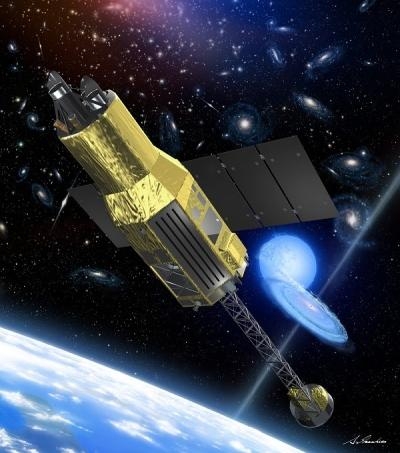Thu, Apr 12, 2012
Mission Will Study Black Holes, Neutron Stars, Other 'Extreme Phenomena'
An agreement has been signed by ESA and the Japanese Aerospace Exploration Agency (JAXA) for cooperation on Astro-H, an important mission that will provide a unique opportunity for probing extreme phenomena in the Universe. Astro-H will study astrophysical objects including black holes and neutron stars, explore the non-thermal Universe, and investigate the large-scale structure of the Universe and its evolution.

The agreement was signed on March 16 by Professor Alvaro Giménez Cañete, ESA Director of Science and Robotic Exploration, and Dr Junjiro Onoda, Director General of the Japanese Institute of Space and Astronautical Science (ISAS). The agreement will see ESA providing JAXA with hardware components and support for operations and users. In return, ESA will be granted observing time on the Astro-H mission, to be allocated to scientists at institutions in ESA Member States through an open Announcement of Opportunity.
JAXA’s Astro-H mission is the sixth in a series of successful X-ray missions initiated by ISAS in Japan, beginning with the launch of the Hakucho mission in 1979 through to the current Suzaku mission. Astro-H will investigate the physics of the high-energy Universe by performing high-resolution, high-throughput spectroscopy with moderate spatial resolution over the 0.3–600 keV energy range. The launch is planned for 2014 from Tanegashima Space Center.
The mission will carry a unique set of innovative instruments, which are:
- Soft and Hard X-ray Imagers (SXI and HXI) to provide imaging spectroscopy in the 0.4–80 keV energy range.
- A Soft Gamma-ray Detector (SGD) to provide high-sensitivity observations in the 40–600 keV energy range.
- An X-ray micro-calorimeter spectrometer (SXS-XCS) to provide fine spectroscopic capability over an energy range of 0.3–12 keV.
This agreement follows a long series of cooperations between ESA and JAXA in space science (ISO, Akari, BepiColombo), as well as cooperation between ESA and Japan in other fields, such as Earth observation (ALOS Date Node, EarthCARE), and telecommunications (Artemis/OICETS), and as partners of the International Space Station.
More News
He Attempted To Restart The Engine Three Times. On The Third Restart Attempt, He Noticed That Flames Were Coming Out From The Right Wing Near The Fuel Cap Analysis: The pilot repor>[...]
Make Sure You NEVER Miss A New Story From Aero-News Network Do you ever feel like you never see posts from a certain person or page on Facebook or Instagram? Here’s how you c>[...]
From 2009 (YouTube Edition): Leading Air Show Performers Give Their Best Advice for Newcomers On December 6th through December 9th, the Paris Las Vegas Hotel hosted over 1,500 air >[...]
Aero Linx: NASA ASRS ASRS captures confidential reports, analyzes the resulting aviation safety data, and disseminates vital information to the aviation community. The ASRS is an i>[...]
“For our inaugural Pylon Racing Seminar in Roswell, we were thrilled to certify 60 pilots across our six closed-course pylon race classes. Not only did this year’s PRS >[...]
 NTSB Final Report: Rutan Long-EZ
NTSB Final Report: Rutan Long-EZ ANN FAQ: Turn On Post Notifications
ANN FAQ: Turn On Post Notifications Classic Aero-TV: ICAS Perspectives - Advice for New Air Show Performers
Classic Aero-TV: ICAS Perspectives - Advice for New Air Show Performers ANN's Daily Aero-Linx (06.28.25)
ANN's Daily Aero-Linx (06.28.25) Aero-News: Quote of the Day (06.28.25)
Aero-News: Quote of the Day (06.28.25)



